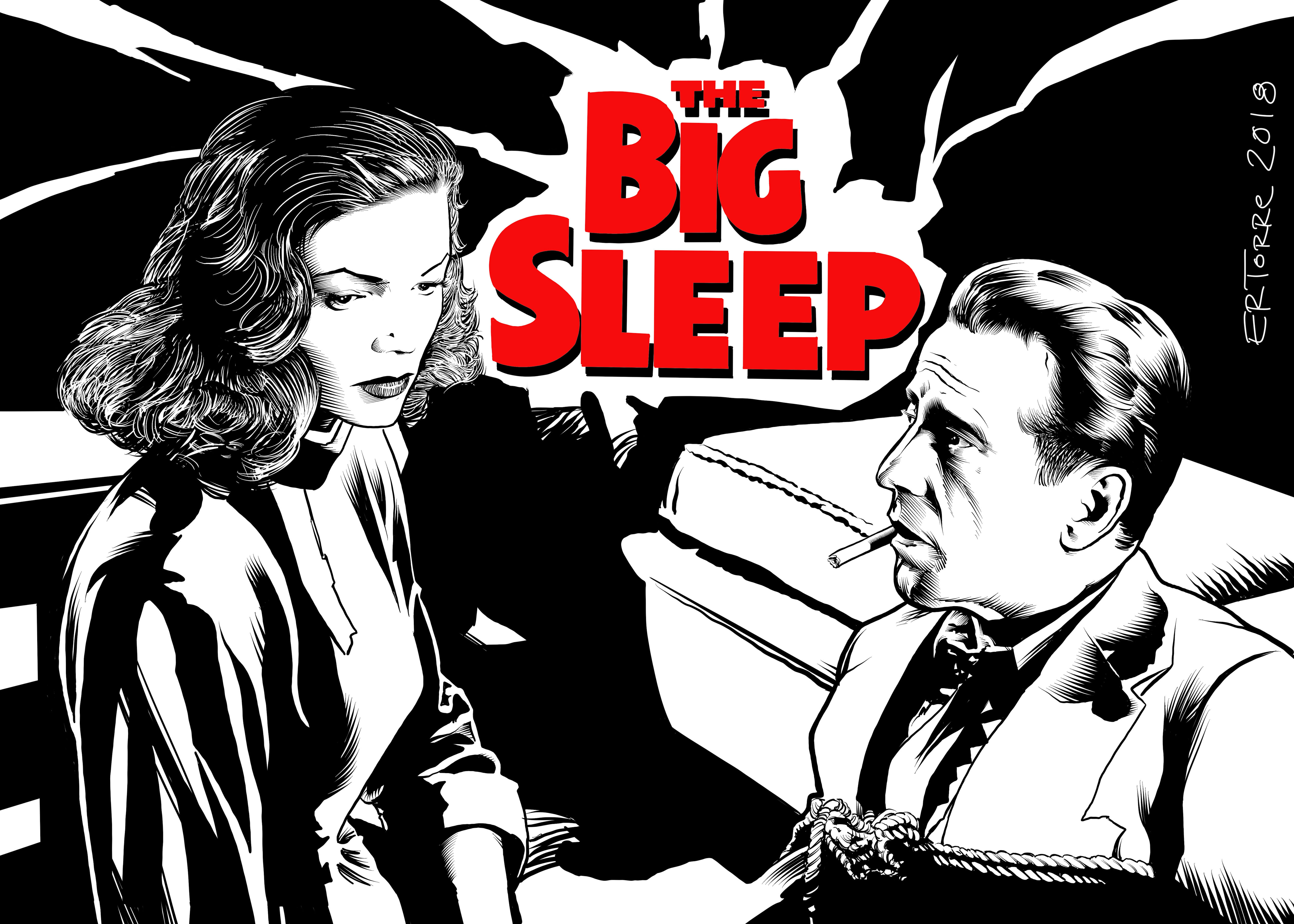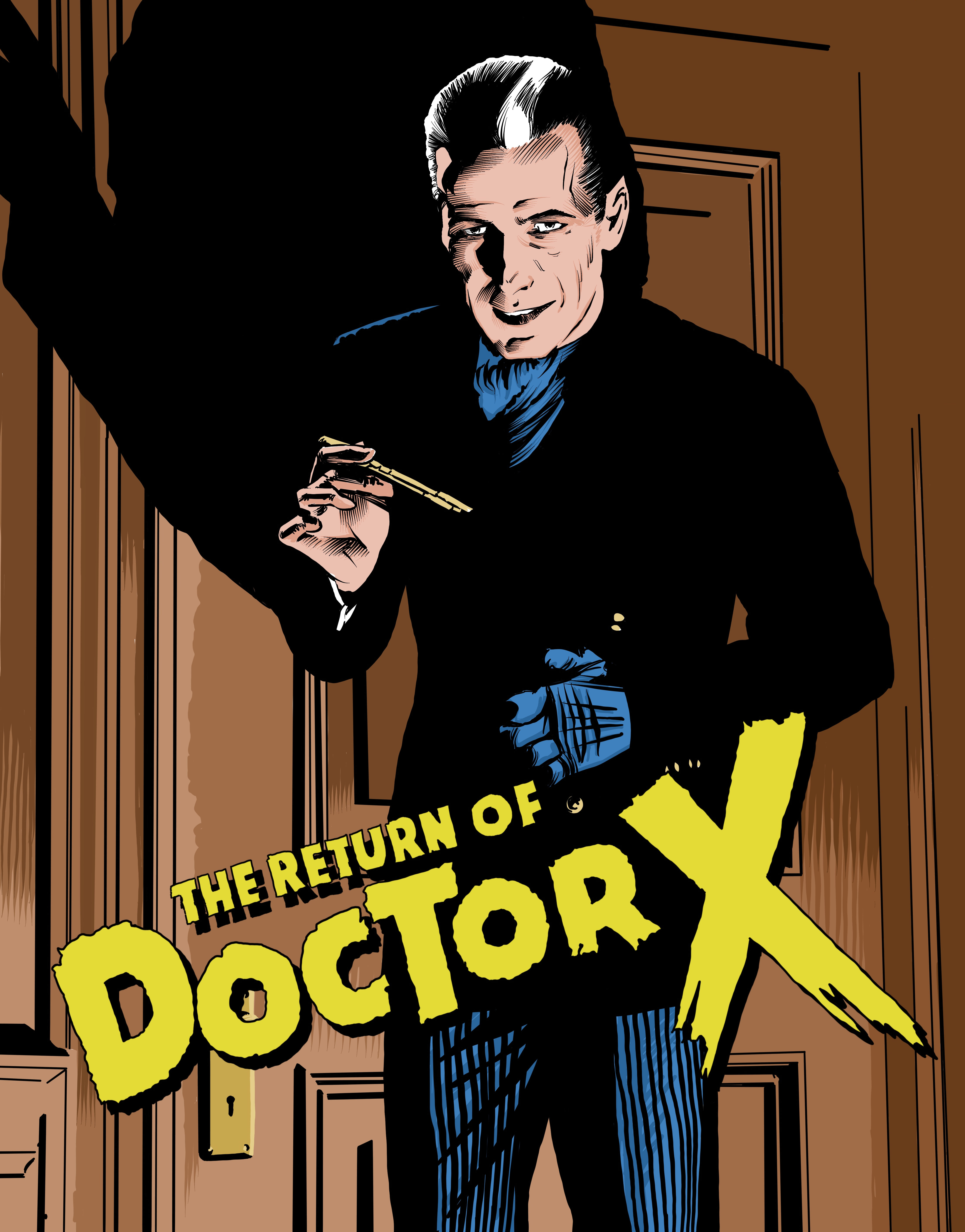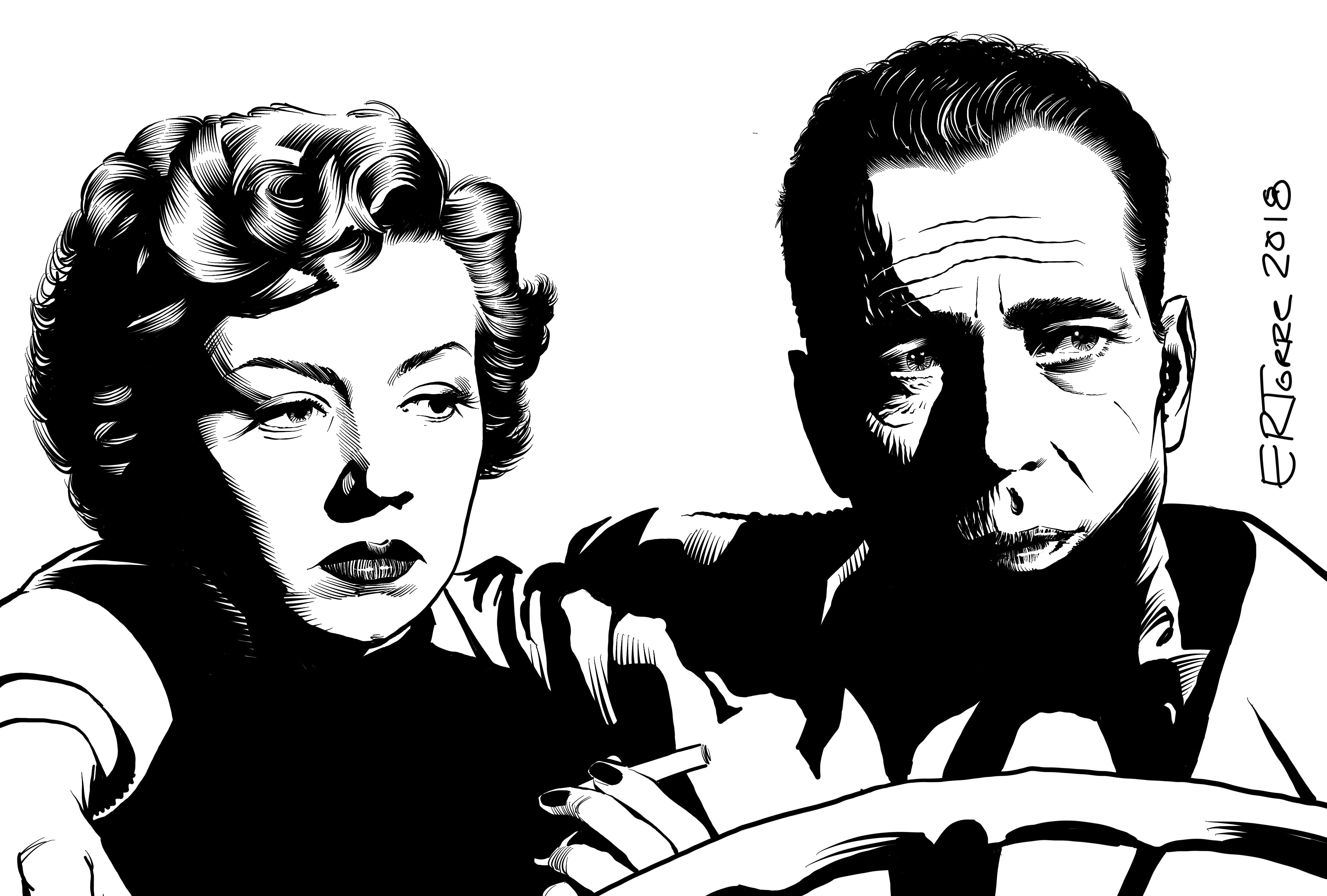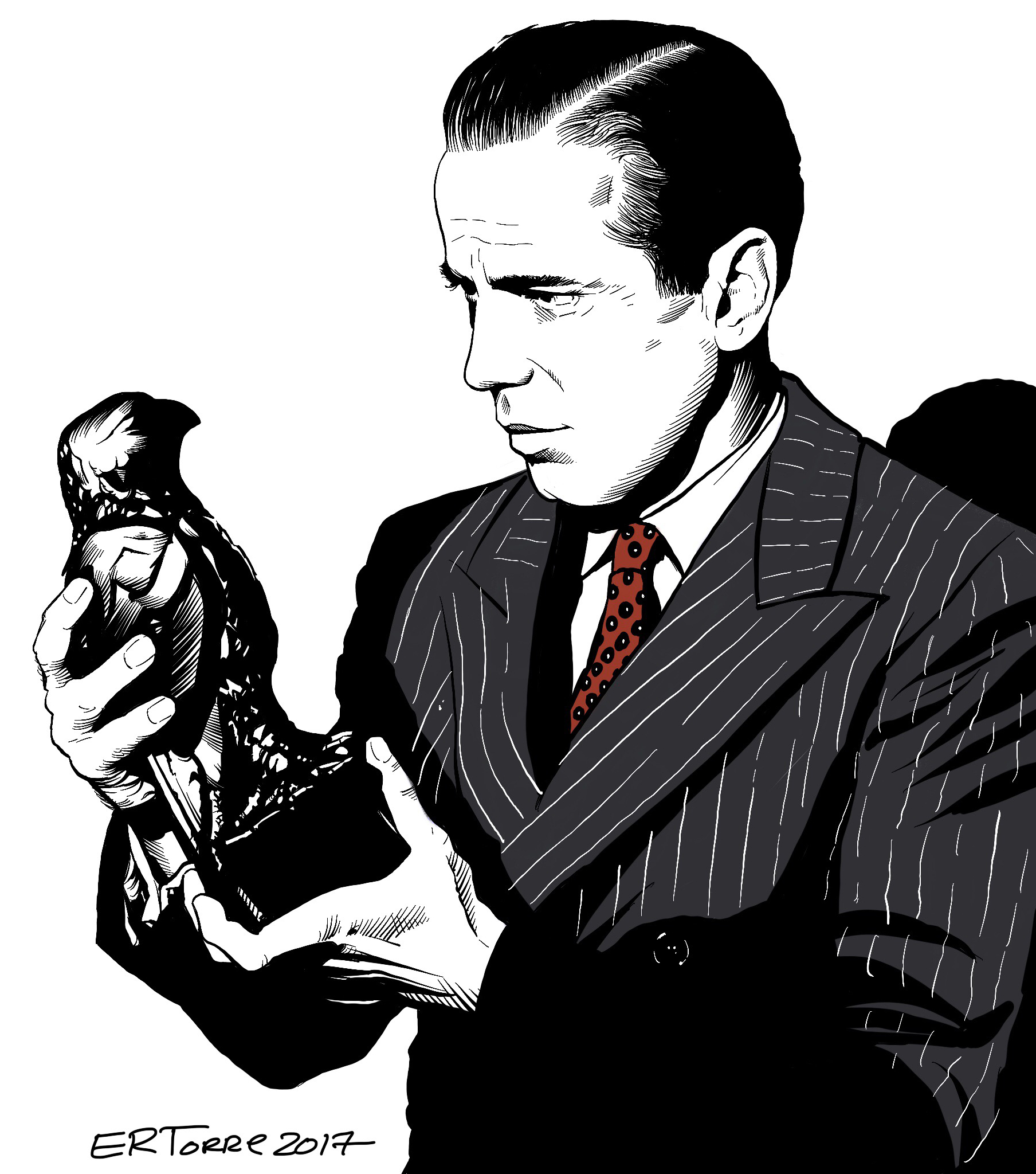Film noir arguably first began with features released in the 1930’s. Influenced at least visually by the stark -and very stylish!- black and white imagery coming out of some of the great German films, one could look at Fritz Lang’s M (1931) as a prototype of what became the film noir crime feature. The US remake of the film, released in 1951 and also titled M, was a surprisingly good remake and if one doesn’t consider the Lang film noir, there is little doubt the American version is noir through and through.
One of the biggest stars of the noir movement is Humphrey Bogart. He would appear in several noir films, perhaps most famous of them being The Maltese Falcon (1941). Dead Reckoning is another fascinating Bogart starring noir and feels an awful lot like a lighter version of The Big Sleep (1946), which starred Bogart and Lauren Bacall and which was released the year before Dead Reckoning.
The Big Sleep was based on Raymond Chandler’s classic first Phillip Marlowe novel and benefitted tremendously from the charisma between the two stars (who would marry). Dead Reckoning, unfortunately, doesn’t have quite that literary backbone to prop it’s story up though I thought Lizabeth Scott did a great job as the love interest/possible femme fatale (a role very similar to that of Bacall’s in The Big Sleep). In fact, so similar is Scott to Bacall that there’s at least one sequence where she’s dressed so similarly to something I recall seeing Bacall in that I actually thought they snuck her into the movie somehow…!
Anyway, this would be Scott’s first “big” role and she did well with it. Bogie was also quite good and displayed his usual charisma… though I admit it felt like he wasn’t doing too much heavy lifting in the role. He did well but it wasn’t Bogie in Casablanca or The Big Sleep or The Maltese Falcon… but it was Bogie and that alone is sometimes good enough!
The story? Bogie and an army buddy are escorted post haste following the end of WWII from their hospital (they were injured in combat but to look at both of them they seem mighty healthy to me!) to receive a Congressional Medal of Honor. Bogie says it was all his partner’s actions and that he was just there for the ride, but when his partner realizes he will be photographed and become a media darling, he bails.
Bogie searches for him and tries to unravel the mystery of why his friend would suddenly want to disappear from the face of the earth and that leads him to his partner’s real name and home town… and a mysterious murder which he may have committed and an old flame (guess who) who may or may not hold secrets of her own along with a casino owner who has ties with then modern (now old time) mobsters.
What secrets will Bogie uncover and whodunnit?
Watch and find out!
Anyway, I recommend the film to anyone interested in delving into 40’s era film noir. It’s a decent film that certainly tries hard to fit into the Chandler mode and, while it doesn’t quite reach that lofty level, it is an entertaining work.
Yes indeed.
…Yep…
Ok, I can’t stop there. But to talk more about this film I’m going to have to get into SPOILERS so… you’ve been warned!
Still there?
Ok, here goes.
Sometimes it feels like the writer in me is ruining all manner of entertainment that involves a story being told. For example, when I reviewed Indiana Jones and the Dial of Destiny a few days back, I noted that the film felt like it had a story that was being worked on as the film was being made. How else to explain odd bits like Antonio Banderas in what amounts to an almost wordless cameo role and one of the main characters seeming to be originally written as perhaps a femme fatale (just scroll to the previous review and it will all be clear!).
Watching Dead Reckoning, I felt those same issues rearing their head.
Again, I enjoyed the film and felt it was worth recommending even though it felt like the film’s makers were endeavoring to imitate a Raymond Chandler type story and not quite hitting the mark.
The story, as I noted, involves Bogie and his partner being transported like royalty to Washington to receive, they find along the way, a Congressional Medal of Honor for their valor in the battlefield. Bogie’s partner bails because clearly he does not want his face all over the papers and Bogie becomes a detective and pursues his friend, whom he finds had an alias and might have been responsible for a murder in his hometown and before he enlisted and got away from the U.S.
This is all interesting stuff but the main point of the film is to get Bogie and Scott together. Scott’s character, it turns out, was the murdered man’s wife and Bogie’s friend’s supposed girlfriend. Scott’s character later clarifies that he loved her but she never quite loved him. Bogie’s friend’s fate, too, is revealed shortly after Bogie begins the investigation and suddenly there’s more skullduggery going on in the quaint town…!
Anyway, the film soon introduces us to a few characters, including a casino owner with mob ties and his henchman as well as a Police Detective who is always one step behind Bogie.
But the crux of the movie’s plot is the question of whether Scott’s character is a “good girl” or secretly a “femme fatale”.
Based on the way the film unfolded, I felt those behind the cameras had no clue which way to go there and, in the end, flipped a coin to determine whether she was good or bad.
The fact is within the film there is no real logic about Scott’s character and the shifts regarding her grow rather silly. When first introduced Bogie is highly suspicious of her and is constantly “testing” her to see if she is good or bad. She seems to pass the tests… that is until something happens that arouses Bogie’s suspicions and we’re off to the next set piece and the next “is she or isn’t she?” setup.
Towards the later stages of the film Bogie’s character seems convinced she is bad and has him accuse her of this or “prove” she isn’t. Bogie’s character forces her to call the police and tell them what really happened a few years back with regard to her husband’s murder. She admits to shooting him but claims it was in self-defense and that the shady casino owner is holding the murder weapon over her head for blackmail and… sheesh. She tearfully picks up the phone, calls the police, and is about to make her confession when Bogie hangs the phone up.
He says something to the effect that he had to push her to the limits to prove she was good, the implication being that she’d good.
Only problem is that the film still has some fifteen or so minutes to go and we wind up (I told you there were SPOILERS!) finding out that Bogie’s character isn’t a very good detective because -suprise and holy whiplash!- the final minutes prove she’s indeed a femme fatale.
Her comeuppance is a car crash leaves her on the verge of dying but still looking awfully beautiful in the hospital bed. Bogie gets to see her that one last time and says nice things to her as she passes away.
Yeah, the writer in me felt the conclusion was a last minute invention and almost certainly tacked on.
It is what it is…!
Oh, and one very fascinating thing about this 1947 film: Bogie’s character is a paratrooper and he talks about saying “Geronimo” before jumping out of the airplane.
The other characters in the film are oblivious to this term and I found it incredibly fascinating that at this point in time, again 1947, the “Geronimo” followed by jumping out of an airplane was something seemingly not known by the general public.
Perhaps this movie was the one that made the public aware of this?
I wonder.




